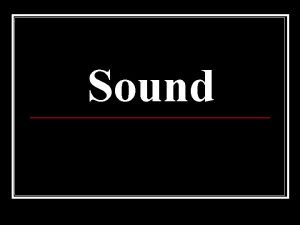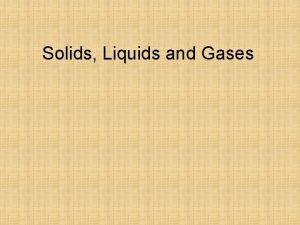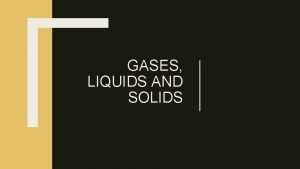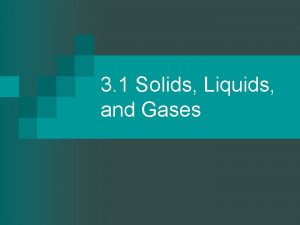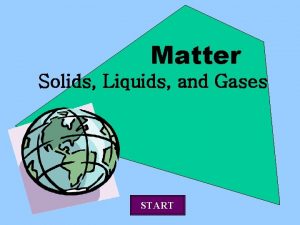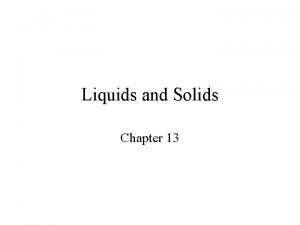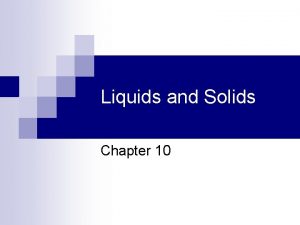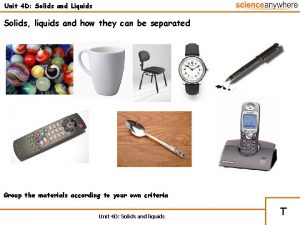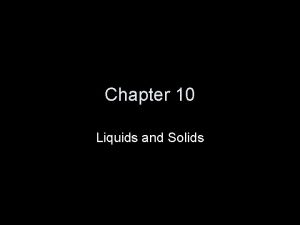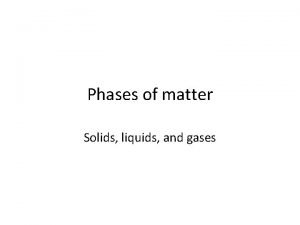Pressure Solids Liquids and Gases Normal matter is

![Solids, Liquids, and Gases ] Normal matter is made of atoms. Atoms can interact Solids, Liquids, and Gases ] Normal matter is made of atoms. Atoms can interact](https://slidetodoc.com/presentation_image_h2/92a4edb51b5871cbabe4ac029b7c5e8c/image-2.jpg)
![Density ] Matter has mass and takes up volume. ] The ratio of the Density ] Matter has mass and takes up volume. ] The ratio of the](https://slidetodoc.com/presentation_image_h2/92a4edb51b5871cbabe4ac029b7c5e8c/image-3.jpg)
![Pressure ] Matter can exert the same force in all directions. ] The ratio Pressure ] Matter can exert the same force in all directions. ] The ratio](https://slidetodoc.com/presentation_image_h2/92a4edb51b5871cbabe4ac029b7c5e8c/image-4.jpg)
![Volume Stress ] Pressure from all sides can change the volume of a solid. Volume Stress ] Pressure from all sides can change the volume of a solid.](https://slidetodoc.com/presentation_image_h2/92a4edb51b5871cbabe4ac029b7c5e8c/image-5.jpg)
![Bulk Modulus P ] Pressure changes volume, not length. ] Bulk modulus B relates Bulk Modulus P ] Pressure changes volume, not length. ] Bulk modulus B relates](https://slidetodoc.com/presentation_image_h2/92a4edb51b5871cbabe4ac029b7c5e8c/image-6.jpg)
![Under Pressure ] ] Steel has a bulk modulus of B = 60 GPa. Under Pressure ] ] Steel has a bulk modulus of B = 60 GPa.](https://slidetodoc.com/presentation_image_h2/92a4edb51b5871cbabe4ac029b7c5e8c/image-7.jpg)
![Surface Force ] ] ] Liquids and gases are fluids. Any area in the Surface Force ] ] ] Liquids and gases are fluids. Any area in the](https://slidetodoc.com/presentation_image_h2/92a4edb51b5871cbabe4ac029b7c5e8c/image-8.jpg)
![Fluids at Depth ] Vertical pressures are not the same. • Pressure below is Fluids at Depth ] Vertical pressures are not the same. • Pressure below is](https://slidetodoc.com/presentation_image_h2/92a4edb51b5871cbabe4ac029b7c5e8c/image-9.jpg)
![Deep Sea Force ] The deepest point in the ocean is 11. 3 km. Deep Sea Force ] The deepest point in the ocean is 11. 3 km.](https://slidetodoc.com/presentation_image_h2/92a4edb51b5871cbabe4ac029b7c5e8c/image-10.jpg)
![Surface Tension ] Liquid molecules attract each other. • Cohesion to self • Adhesion Surface Tension ] Liquid molecules attract each other. • Cohesion to self • Adhesion](https://slidetodoc.com/presentation_image_h2/92a4edb51b5871cbabe4ac029b7c5e8c/image-11.jpg)
![Capillary Action ] ] Liquid surfaces adhere to adjacent solids. The contact angle q Capillary Action ] ] Liquid surfaces adhere to adjacent solids. The contact angle q](https://slidetodoc.com/presentation_image_h2/92a4edb51b5871cbabe4ac029b7c5e8c/image-12.jpg)
- Slides: 12

Pressure
![Solids Liquids and Gases Normal matter is made of atoms Atoms can interact Solids, Liquids, and Gases ] Normal matter is made of atoms. Atoms can interact](https://slidetodoc.com/presentation_image_h2/92a4edb51b5871cbabe4ac029b7c5e8c/image-2.jpg)
Solids, Liquids, and Gases ] Normal matter is made of atoms. Atoms can interact to form three types of matter. ] Solid ] • Incompressible • Subject to shear force ] Liquid • Incompressible • Not subject to shear force ] Gas • Compressible • Not subject to shear force
![Density Matter has mass and takes up volume The ratio of the Density ] Matter has mass and takes up volume. ] The ratio of the](https://slidetodoc.com/presentation_image_h2/92a4edb51b5871cbabe4ac029b7c5e8c/image-3.jpg)
Density ] Matter has mass and takes up volume. ] The ratio of the mass to the volume is the density. ] Incompressible materials maintain their density. Salt (solid): 2. 165 x 103 kg/m 3 Water (liquid): 1. 000 x 103 kg/m 3 Nitrogen (gas): 1. 251 kg/m 3
![Pressure Matter can exert the same force in all directions The ratio Pressure ] Matter can exert the same force in all directions. ] The ratio](https://slidetodoc.com/presentation_image_h2/92a4edb51b5871cbabe4ac029b7c5e8c/image-4.jpg)
Pressure ] Matter can exert the same force in all directions. ] The ratio of the force exerted to the area is the pressure. • It’s a scalar, not a vector ] The unit of pressure is the pascal. • 1 Pa = 1 N/m 2 • Same type as stress
![Volume Stress Pressure from all sides can change the volume of a solid Volume Stress ] Pressure from all sides can change the volume of a solid.](https://slidetodoc.com/presentation_image_h2/92a4edb51b5871cbabe4ac029b7c5e8c/image-5.jpg)
Volume Stress ] Pressure from all sides can change the volume of a solid. ] Volume stress measures the pressure. ] Volume strain measures the change in area. P DV V A (surface area)
![Bulk Modulus P Pressure changes volume not length Bulk modulus B relates Bulk Modulus P ] Pressure changes volume, not length. ] Bulk modulus B relates](https://slidetodoc.com/presentation_image_h2/92a4edb51b5871cbabe4ac029b7c5e8c/image-6.jpg)
Bulk Modulus P ] Pressure changes volume, not length. ] Bulk modulus B relates changes in pressure and volume. ] The negative sign represents the decrease in volume with increasing pressure. DV V A (surface area)
![Under Pressure Steel has a bulk modulus of B 60 GPa Under Pressure ] ] Steel has a bulk modulus of B = 60 GPa.](https://slidetodoc.com/presentation_image_h2/92a4edb51b5871cbabe4ac029b7c5e8c/image-7.jpg)
Under Pressure ] ] Steel has a bulk modulus of B = 60 GPa. A sphere with a volume of 0. 50 m 3 is constructed and lowered into the ocean where P = 20 MPa. How much does the volume change? Ø Use the relation for bulk modulus. Ø B = -(DP) / (DV/V) Ø DV= - V DP / B Ø Substitute values: Ø (-0. 50 m 3)(2. 0 x 107 Pa) / (6. 0 x 1010 Pa) Ø DV = -1. 6 x 10 -4 m 3
![Surface Force Liquids and gases are fluids Any area in the Surface Force ] ] ] Liquids and gases are fluids. Any area in the](https://slidetodoc.com/presentation_image_h2/92a4edb51b5871cbabe4ac029b7c5e8c/image-8.jpg)
Surface Force ] ] ] Liquids and gases are fluids. Any area in the fluid experiences equal forces from each direction. This is just the law of inertia. • All forces are balanced • Forces are still vectors ] Any arbitrary volume in the has balanced forces.
![Fluids at Depth Vertical pressures are not the same Pressure below is Fluids at Depth ] Vertical pressures are not the same. • Pressure below is](https://slidetodoc.com/presentation_image_h2/92a4edb51b5871cbabe4ac029b7c5e8c/image-9.jpg)
Fluids at Depth ] Vertical pressures are not the same. • Pressure below is higher • Pressure above is less • Include the weight Ft Fb Fg
![Deep Sea Force The deepest point in the ocean is 11 3 km Deep Sea Force ] The deepest point in the ocean is 11. 3 km.](https://slidetodoc.com/presentation_image_h2/92a4edb51b5871cbabe4ac029b7c5e8c/image-10.jpg)
Deep Sea Force ] The deepest point in the ocean is 11. 3 km. Ø Ø ] Ø h is positive with depth. What is the pressure at that depth? • P 0 = 1. 013 x 105 Pa • Water r = 1000. kg/m 3 1 bar = 1. 00 x 105 Pa 1 atm = 1013 millibar 1 atm = 14. 7 psi The pressure increases linearly with depth. Solve for P = P 0 + rgh. Ø Substitute values: Ø rgh = 1. 11 x 108 Pa. Ø This is much larger than P 0. Ø P = 1. 11 x 108 Pa Ø This is 1100 atm!
![Surface Tension Liquid molecules attract each other Cohesion to self Adhesion Surface Tension ] Liquid molecules attract each other. • Cohesion to self • Adhesion](https://slidetodoc.com/presentation_image_h2/92a4edb51b5871cbabe4ac029b7c5e8c/image-11.jpg)
Surface Tension ] Liquid molecules attract each other. • Cohesion to self • Adhesion to other material ] At the surface this force is the surface tension. • Force per length parallel to the surface: g • Constant for different liquids insect leg on water
![Capillary Action Liquid surfaces adhere to adjacent solids The contact angle q Capillary Action ] ] Liquid surfaces adhere to adjacent solids. The contact angle q](https://slidetodoc.com/presentation_image_h2/92a4edb51b5871cbabe4ac029b7c5e8c/image-12.jpg)
Capillary Action ] ] Liquid surfaces adhere to adjacent solids. The contact angle q depends on the liquid and solid. ] The surface tension can support a weight of fluid.
 Expansion of solids liquids and gases examples
Expansion of solids liquids and gases examples Buoyancyability
Buoyancyability Venn diagram gas liquid solid
Venn diagram gas liquid solid The properties of solids liquids and gases
The properties of solids liquids and gases Examples of solids liquids and gases pictures
Examples of solids liquids and gases pictures Lesson outline lesson 1 solids liquids and gases answer key
Lesson outline lesson 1 solids liquids and gases answer key Chapter 14 solids liquids and gases worksheet answers
Chapter 14 solids liquids and gases worksheet answers Kinetic molecular theory of liquids and solids
Kinetic molecular theory of liquids and solids Particle movement in solids liquids and gases
Particle movement in solids liquids and gases How does sound travel through solids liquids and gases
How does sound travel through solids liquids and gases Liquid information
Liquid information Motion of particles in solids, liquids and gases
Motion of particles in solids, liquids and gases Why is gas easy to compress
Why is gas easy to compress









